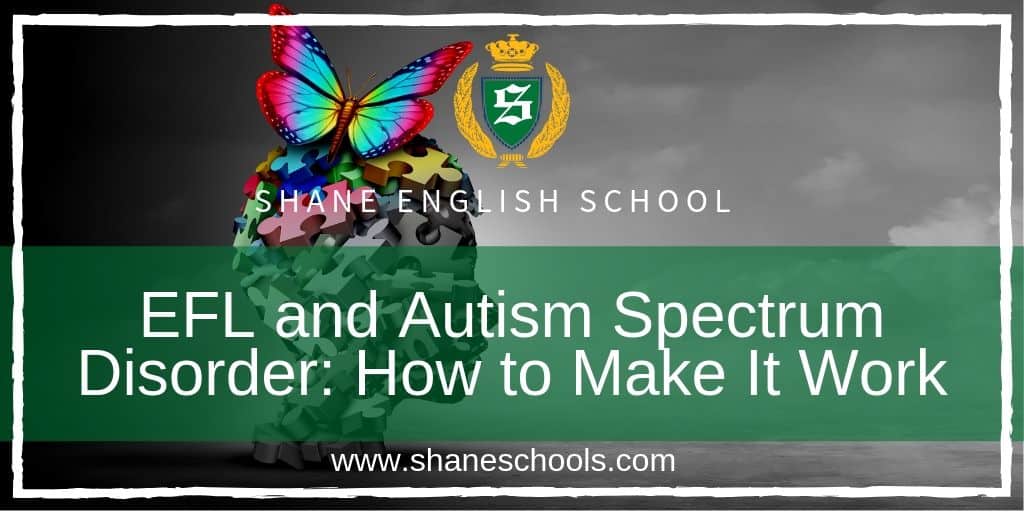In recent years, there has been a distinct rise in autism spectrum disorders, also called autistic spectrum disorders or ASD. The exact cause of this rise is still under debate, though genetics, waiting until later in life to have children, and lifestyle changes are all potential factors. (No, vaccines are not potential causes.) It’s also possible that we are using more sophisticated diagnostic measures to better identify students on the autism spectrum, so there is a higher rate of diagnosis, not necessarily a higher rate of autism. It’s inevitable that EFL and autism spectrum disorder meet.
As an EFL teacher, you are likely to encounter a student—either diagnosed or undiagnosed—that has some form of ASD. Adding the extra layer of challenge to learning a foreign language can be frustrating for everyone involved: teachers, parents, classmates, and the student.

A ‘meltdown’ or extreme emotional response is upsetting for everyone involved, especially the child.
Common Symptoms of Autism Spectrum Disorder (ASD)
Autism spectrum disorder (ASD) is a broad term that helps identify people whose thought process is different in certain ways. At its simplest description, autism is a barrier to communication. Severe cases completely eliminate a person’s ability to understand others and verbalise their own thoughts. But even in less severe cases, where someone is diagnosed with autistic spectrum disorder, there can be significant Impediments.
Some communication-related symptoms could include:
- Unusual emotional reactions to others and the environment.
- Emotional outbursts when routines are broken.
- Body language that does not match verbalisation.
- Inconsistent eye contact.
- Limited ability to understand others’ points of view.
- Restricted range of intense interests.
- Difficulty making or maintaining friendships.
Likewise, ESL students on the autistic spectrum may also exhibit repetitive or ritualised behaviour. This could extend to daily routines, their interactions with others, and even individual play:
- Hand-flapping.
- Unusual vocalisation, like repeated words or sounds.
- Involuntarily repeating what others say.
Depending on the severity of these symptoms, students with autistic spectrum disorder could be fully capable of participating in standard classes, or they may require special accommodation. However, those EFL students whose autistic spectrum disorder does not hinder them may enjoy certain advantages:
- Above-average IQ.
- Good memory for facts and information.
- Strong auditory and visual learners.
For more details on autistic spectrum disorder, this is another great resource.
Teaching EFL to Autistic Spectrum Students
When a student exhibits these symptoms, it benefits everyone in class to make certain adjustments. One of the primary challenges to young people on the autistic spectrum is containing and managing emotions. This inability to control one’s emotions often results in outburst and tantrums, which can be disruptive or even violent. Luckily, there are a few broad principles that can help maintain a calm classroom environment and facilitate education of all students.
- Be clear and direct. Even in their native languages, many people with autistic spectrum disorder have difficulty with figurative language. They take everything literally. The challenge is doubled when a student is trying to operate in another language. Therefore, it’s important to avoid figures of speech and idioms as much as possible. Likewise, instructions must be linear and easy to follow. Finally, open questions can be confusing. Instead, consider either-or constructions. (e.g. ‘Would you like an apple or an orange?’ NOT ‘What would you like?’)
- Have (and follow) rules. Though students on the autistic spectrum have a reputation for being wild and out of control, many young people with ASD prefer order and routine. Rules offer this order. By teaching these students rules of grammar, rules of behaviour, and rules of social interaction, a teacher will likely find students on the autism spectrum are remarkably polite and helpful. However, these rules must be followed consistently (by everyone), or the autistic student is likely to get stressed and upset.
There are strategies to help students on the autism spectrum achieve their goals.
- Minimise stimulation. One of the possible symptoms of autistic spectrum disorder is hypersensitivity to light or sound, so a more austere environment will definitely limit autistic students’ outbursts. (Of course, neurotypical EFL students respond well to a wealth of stimulation, so it may be necessary to strike a balance.) Minimising stimulation also applies to emotional stimulation. An over-happy student with ASD could lash out just as easily as an angry student, so emotional management is key. And an essential first step is to make very sure other EFL students don’t bully or tease the student on the autistic spectrum, and that an ASD student having an outburst is removed from the source of over-stimulation.
- Respect the student’s interests and limitations. While it is fine to encourage an ESL student with ASD push boundaries, it’s important to remember that pushing too hard will likely result in an unpleasant experience for all. And while it’s acceptable to brush up against these students’ limitations, even discipline them, it is also important to remember that autistic students may have outbursts and have difficulty getting their emotions under control. Teachers must recognise this behaviour and make sure ESL students with autistic spectrum disorder be given the space to ‘cool down’, which wouldn’t be a bad idea for most neurotypical students as well.
The above suggestions are the broad strokes. It is also important to respond to the individual needs of a student with ASD. For the vast majority of ESL students on the autistic spectrum, it is possible to succeed with the right help and guidance. For additional tips, this article has an excellent list of detailed suggestions: 22 Tips for Teacher Students with Autism Spectrum Disorder.
Proper Diagnosis of Autism Spectrum Disorder
You are most likely a great educator who has seen it all (or soon will). Diagnosing mental health disorders should be left to the trained professionals, however. It is not a teacher’s place to tell parents that their child has autism, even when all signs point to it. At best, you can suggest assessments to see if there is some way to better serve the student’s best interests.
Recommending testing for mental health issues can be sensitive. It’s never easy for parents to hear that their students may have problems. Parents may respond with anger, especially in cultures where mental health issues can cause parents to lose face. When teaching abroad, it’s important to consult with local staff on the best way to proceed before suggesting testing and diagnosis.
Alternatively, we can use some of the strategies above to see if anything works to help an EFL student potentially on the autism spectrum, as these strategies could just as easily benefit a neurotypical student. There is also the possibility that a label of autism spectrum disorder would be limiting to a student, depending on cultural stigma and support structures at school. Therefore, in cases where the student finds their challenges manageable, it is the teacher’s responsibility to simply teach them, regardless of what labels might be attached.
Even with proper diagnosis, it’s important to remember that autism spectrum disorder is not a linear spectrum, but much more complex, as is beautifully explained in this cartoon: Comic Redesigns the Autism Spectrum to Crush Stereotypes.
About the Author
Daniel Howard has been working Taiwan as an EFL teacher and writer in the English-education industry for the past 11 years. He has taught students of all ages and abilities, including students with autism spectrum disorder. Currently, he is the Group Social Media Manager for the Saxoncourt Group.

We're hiring!
With schools around the world, Shane English School always has exciting new opportunities to offer.



